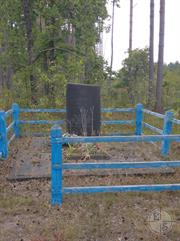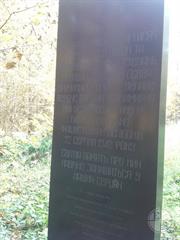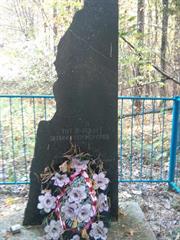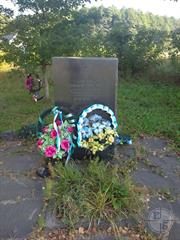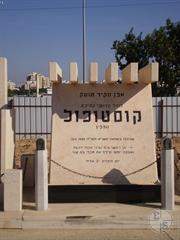Kostopil
Rivne district, Rivne region
Sources:
- "Kostopol", [in:] Pinkas Hakehillot Polin: Encyclopedia of Jewish Communities, Poland, Volume V. Yad Vashem, Jerusalem, 1990. Translated by Meir Garbarz Gover, JewishGen, Inc.
- Jewish encyclopedia of Brockhaus & Efron;
- Russian Jewish encyclopedia. Translated from Russian by Eugene Snaider;
- The All South-Western Territory: reference and address book of the Kyiv, Podolsk and Volyn provinces. Printing house L.M. Fish and P.E. Wolfson, 1913;
- Yad Vashem. Kostopol
Photo:
- Pinkas Hakehillot Polin: Encyclopedia of Jewish Communities, Poland, Volume V
- Biblioteka Narodowa Polona. Kostopol
- David Shay, Wikipedia. Kostopol Jewery Holocaust memorial at Holon Cemetery
- Pavlo kost, Wikipedia. The place of execution of Jews in Kostopil. Photo 1; Photo 2.
- Pavlo kost, Wikipedia. Monument to victims of fascism. Photo 1; Photo 2.
- "Kostopol", [in:] Pinkas Hakehillot Polin: Encyclopedia of Jewish Communities, Poland, Volume V. Yad Vashem, Jerusalem, 1990. Translated by Meir Garbarz Gover, JewishGen, Inc.
- Jewish encyclopedia of Brockhaus & Efron;
- Russian Jewish encyclopedia. Translated from Russian by Eugene Snaider;
- The All South-Western Territory: reference and address book of the Kyiv, Podolsk and Volyn provinces. Printing house L.M. Fish and P.E. Wolfson, 1913;
- Yad Vashem. Kostopol
Photo:
- Pinkas Hakehillot Polin: Encyclopedia of Jewish Communities, Poland, Volume V
- Biblioteka Narodowa Polona. Kostopol
- David Shay, Wikipedia. Kostopol Jewery Holocaust memorial at Holon Cemetery
- Pavlo kost, Wikipedia. The place of execution of Jews in Kostopil. Photo 1; Photo 2.
- Pavlo kost, Wikipedia. Monument to victims of fascism. Photo 1; Photo 2.
Kostopil (ukr. Костопіль, rus. Костополь), city (since 1939), until 2020 - the district center in the Rivne region. Founded in 1783. In the 16-18 centuries - the township of Lutsk powiat of Volyn Voivodeship as part of the Commonwealth. Since 1793 - as part of the Russian Empire. In the 19th - early 20th centuries - the township of Rivne district of the Volyn province. In 1919–39 - in the Volyn Voivodeship as part of Poland, in 1939–91 - as part of the Ukrainian SSR.
Up to the 1780's Kostopil was a small village and Iron mine named Ostlec Wielki. In 1792, owner of the estate magnate Leonard Wortzel, received from king Stanislaw August Poniatowski, town privileges for his estate including the right for an annual fair. Magnate Wortzel inhabited the town with farmers and Jews, and build inns. He changed town's name to Kostopol, to name it after his daughter's name Konstantyna.
In 1847, 153 Jews lived in Kostopil,
in 1897 - 1101 (64.5%),
in 1921 - 1185 (39.6%),
in 1931 - 2609 (39.9%),
In 1937 - 3920 (40%) Jews.
Jewish population grew gradually, but increased towards the end of the 1890's when a local train station was built on the Rovno-Vilna line. There after plants were erected to process agriculture products: two flour mills, Oil press, spinning mill, sawmill, and a match factory.
Up to the 1780's Kostopil was a small village and Iron mine named Ostlec Wielki. In 1792, owner of the estate magnate Leonard Wortzel, received from king Stanislaw August Poniatowski, town privileges for his estate including the right for an annual fair. Magnate Wortzel inhabited the town with farmers and Jews, and build inns. He changed town's name to Kostopol, to name it after his daughter's name Konstantyna.
In 1847, 153 Jews lived in Kostopil,
in 1897 - 1101 (64.5%),
in 1921 - 1185 (39.6%),
in 1931 - 2609 (39.9%),
In 1937 - 3920 (40%) Jews.
Jewish population grew gradually, but increased towards the end of the 1890's when a local train station was built on the Rovno-Vilna line. There after plants were erected to process agriculture products: two flour mills, Oil press, spinning mill, sawmill, and a match factory.
WWI cut off the town from west Europe. Many refugees passed through and were helped by the local Jews. After the 1917 Communist revolution parties were established: “Zionism Union”, “Zion Youth”, and “Zion workers”.
The German occupation of 1917-1918 brought economic improvement. Jewish self defense force was established. Bribes were paid to Petlura soldiers to avoid local Pogroms. Bolshevik collaborators were executed.
There were periods of hunger and plagues but no death victims.
The JOINT helped to restore Jewish life after WWI. 1921 Census showed stability in the number of Jews. In 1925 Kostopol became the district capital and the district governor's offices. This increased town's development. Three lumber yards operated in town; two of them under Jewish ownership and one was government owned. The third big Plywood factory, Jewish owned, operated in Kostopol, 2 furniture factories, 2 glass factories, 2 agriculture machinery casting and forging factories, 3 flour mills 2 of them Jewish owned, 2 oil presses, 4 tar and turpentine factories, and a brick factory, all of which were operational in Kostopol.
In nearby Janova Dolina two Granite and basalt quarries were opened. The quarries were connected by train line to the Kostopol train station. The Polish government initiated housing projects for the quarries workers. Most government workers were not Jewish, but the Jews supplied the infrastructure to service those workers.
The German occupation of 1917-1918 brought economic improvement. Jewish self defense force was established. Bribes were paid to Petlura soldiers to avoid local Pogroms. Bolshevik collaborators were executed.
There were periods of hunger and plagues but no death victims.
The JOINT helped to restore Jewish life after WWI. 1921 Census showed stability in the number of Jews. In 1925 Kostopol became the district capital and the district governor's offices. This increased town's development. Three lumber yards operated in town; two of them under Jewish ownership and one was government owned. The third big Plywood factory, Jewish owned, operated in Kostopol, 2 furniture factories, 2 glass factories, 2 agriculture machinery casting and forging factories, 3 flour mills 2 of them Jewish owned, 2 oil presses, 4 tar and turpentine factories, and a brick factory, all of which were operational in Kostopol.
In nearby Janova Dolina two Granite and basalt quarries were opened. The quarries were connected by train line to the Kostopol train station. The Polish government initiated housing projects for the quarries workers. Most government workers were not Jewish, but the Jews supplied the infrastructure to service those workers.
In the 19th - early 20th centuries Jews made their living from small trade and crafts.
From 1884, Shmuel Zilbershtein from Miedzyrzec Podalski was a rabbi in Kostopil (1860 -?), then - his son Asher (? –1932).
A 1906 fire destroyed most of the town's buildings. There after most houses, including a big synagogue were erected using bricks. Jewish Kindergartens – cheders, private girls' school were established. The poet Jacob Lerner established a Hebrew school.
In 1914, Jews owned the only pharmacy and the only warehouse of pharmacy products, 44 of 45 grocery shops, the only sawmill and all 3 wood warehouses, the furniture, glass and cast-iron factories, all 3 hotels.
All 3 doctors in the township were Jews.
From 1884, Shmuel Zilbershtein from Miedzyrzec Podalski was a rabbi in Kostopil (1860 -?), then - his son Asher (? –1932).
A 1906 fire destroyed most of the town's buildings. There after most houses, including a big synagogue were erected using bricks. Jewish Kindergartens – cheders, private girls' school were established. The poet Jacob Lerner established a Hebrew school.
In 1914, Jews owned the only pharmacy and the only warehouse of pharmacy products, 44 of 45 grocery shops, the only sawmill and all 3 wood warehouses, the furniture, glass and cast-iron factories, all 3 hotels.
All 3 doctors in the township were Jews.
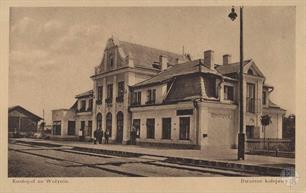 |
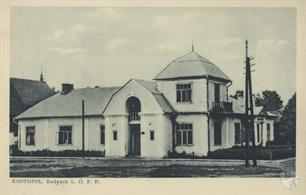 |
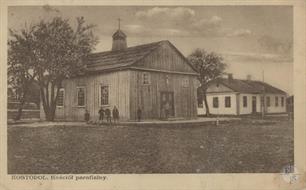 |
| Railstation in Kostopil, 1932-1937 | Kostopil, house of LOPP (Airborne and Antigas Defence League in Polsnd, founded in 1928) | Kostopil, woodrn church, 1927-1930 |
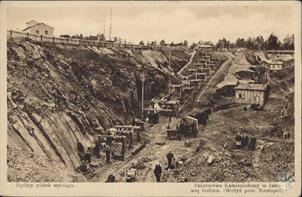 |
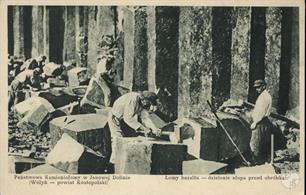 |
 |
| Basalt quarries in Janova Dolyna near Kostopil, 1930s | Work in basalt quarry | Basalt pillars in a carry, 1930s |
In the 30s there were 260 stores in Kostopil, 180 of them Jewish owned. Jewish merchants controlled the grain, cattle, eggs, iron, clothing, textile, pharmacies, and perfumeries industries. 75% of other merchant segments were as well in Jewish hands. About half of the small industry registered shops were owned by Jews. Jews were the majority of tailors, hat makers, painters, watch makers, and semesters.
A Cooperative Bank was established in 1928 by uniting two banks: Commerce Bank of the Merchants Union and National Bank of the Crafters Union (established 1926).
A Benevolent Society was established in 1928. The Bank and the Benevolent Society operated till September 1939.A non Jewish Municipal Savings and Loan Bank were doing business mainly with affluent Jewish merchants and crafters.
In the 20s Jews held 6-8 seats out of the 12 seats in town's council. They were about 40% of town's population and a Jewish vice Mayor served in a non paying capacity. In the 30s number of Jews in town's council dropped to 4-5 and one directorship member: Mr. Lawnik.
In the 1928 Jewish Communities Council elections, Kostopil was joined by nearby Derazhne, Stepan and two Jewish agricultural communities: Osowa and Male Siedliszcze. The candidates were mostly Orthodox Jews. In the 30s elections most elected were of Zionists parties.
A third synagogue in Kostopol was erected in 1924. An additional Rabbi to R' Asher Zilbersztein became R' Mosze Zwi Milman. After R' Zilbersztein died, R' Milman and R' Mosze Szternberg from nearby Aleksandria ran to office. R' Szternberg was elected by mere 32 votes. This caused a community argument, thus, de facto both Rabbis served the community simultaneously.
R' Szternberg immigrated to Eretz Israel in 1937. The Rabbi appointed after him was R' Krieger who perished in the Holocaust with most of Kostopol Jewry.
After WWI, a Hebrew School was open under the management of Zalman Leibowicz (Ariel), an educator from Eretz Israel. The school, a library and a children's infirmary were supported by Joint. After the aid from the Joint was stopped the school was closed bur re-opened in 1926/27. Also the kindergarten and library were re-opened, under the “TARBUT” school chain. All these institutions operated until 1939. Then, under Soviet occupation in September 1939, the school became part of the Soviet education system.
Zionists movements in Kostopol renewed their operations after the 1917 civil war and establishment of Polish rule. The Hebrew Society operated in drama circles and in the library. “He-Chalutz” – “The Pioneer” movement branch was established in the 1920's. 20 candidates for “aliya” (immigration to Eretz Israel) were practicing in a nearby Jewish “Hachshara” farm and sawmill.
“Ha-Shomer Ha-Tzair” – “The Young guard” branch was established in 1926 and soon after became the most influential youth movement in the shtetl.
Two groups of candidates for alyah to Eretz Israel were established: “Kibbutz Wohlina II” and “EL AL”. Their members were among the founders of Kibbutz Negba in Israel.
The Revisionist party was established in 1929 together with its Youth Movement “Beitar”. They became the second largest Youth Movement in town and had their own candidates groups for immigration to Eretz Israel. Up to 1939, 209 of Kostopil youngsters moved to Israel: 114 from “Ha-Shomer Ha-Tzair”, 63 from “He-Chalutz”, 32 from “Beitar”.
A Cooperative Bank was established in 1928 by uniting two banks: Commerce Bank of the Merchants Union and National Bank of the Crafters Union (established 1926).
A Benevolent Society was established in 1928. The Bank and the Benevolent Society operated till September 1939.A non Jewish Municipal Savings and Loan Bank were doing business mainly with affluent Jewish merchants and crafters.
In the 20s Jews held 6-8 seats out of the 12 seats in town's council. They were about 40% of town's population and a Jewish vice Mayor served in a non paying capacity. In the 30s number of Jews in town's council dropped to 4-5 and one directorship member: Mr. Lawnik.
In the 1928 Jewish Communities Council elections, Kostopil was joined by nearby Derazhne, Stepan and two Jewish agricultural communities: Osowa and Male Siedliszcze. The candidates were mostly Orthodox Jews. In the 30s elections most elected were of Zionists parties.
A third synagogue in Kostopol was erected in 1924. An additional Rabbi to R' Asher Zilbersztein became R' Mosze Zwi Milman. After R' Zilbersztein died, R' Milman and R' Mosze Szternberg from nearby Aleksandria ran to office. R' Szternberg was elected by mere 32 votes. This caused a community argument, thus, de facto both Rabbis served the community simultaneously.
R' Szternberg immigrated to Eretz Israel in 1937. The Rabbi appointed after him was R' Krieger who perished in the Holocaust with most of Kostopol Jewry.
After WWI, a Hebrew School was open under the management of Zalman Leibowicz (Ariel), an educator from Eretz Israel. The school, a library and a children's infirmary were supported by Joint. After the aid from the Joint was stopped the school was closed bur re-opened in 1926/27. Also the kindergarten and library were re-opened, under the “TARBUT” school chain. All these institutions operated until 1939. Then, under Soviet occupation in September 1939, the school became part of the Soviet education system.
Zionists movements in Kostopol renewed their operations after the 1917 civil war and establishment of Polish rule. The Hebrew Society operated in drama circles and in the library. “He-Chalutz” – “The Pioneer” movement branch was established in the 1920's. 20 candidates for “aliya” (immigration to Eretz Israel) were practicing in a nearby Jewish “Hachshara” farm and sawmill.
“Ha-Shomer Ha-Tzair” – “The Young guard” branch was established in 1926 and soon after became the most influential youth movement in the shtetl.
Two groups of candidates for alyah to Eretz Israel were established: “Kibbutz Wohlina II” and “EL AL”. Their members were among the founders of Kibbutz Negba in Israel.
The Revisionist party was established in 1929 together with its Youth Movement “Beitar”. They became the second largest Youth Movement in town and had their own candidates groups for immigration to Eretz Israel. Up to 1939, 209 of Kostopil youngsters moved to Israel: 114 from “Ha-Shomer Ha-Tzair”, 63 from “He-Chalutz”, 32 from “Beitar”.
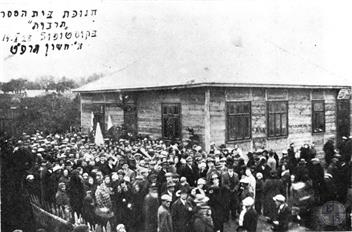 |
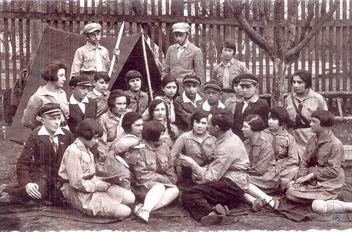 |
| Inauguration of the Tarbut school in Kostopil, 14.10.1928 | Members of Ha-Shomer Ha-Tzair youth movement |
German army occupied Kostopil on 1 July 1941. Already on the first occupation days local Ukraines held a Pogrom and murdered 6 Jewish suspected to be Soviet activists and ravaged Jewish property. The Germans established a Jewish Judenrat and enforced special mark to bear by all Jews. Jews were taken to slave labor in local sawmills, peat mines, train station and sewage facilities.
A forced labor camp was established, manned with Jewish labor, at the “Clerks Residents” on the west part of town.
Workers received daily bread ration of 200 grams. Their families were nourished by a public kitchen operated by the Judenrat. Jewelry, furs and valuables were confiscated. Heavy levies were imposed on the Kostopil Jews.
On 16 August 1941 the Germans gathered 470 Jewish men, including most affluent Jews in the community and Judenrat head Dawid Dajan. They were transported outside of Kostopil and all of them were executed. Their families were rather notified that they were sent to work camps and the families were eluded by the Germans to send them money. The money was confiscated by the Germans. On 1 October 1941 the Germans gathered about 1,400 Jews, family members of the 1st group that was executed. The German promised to transport them to the work camp were their family members are. Instead, this 2nd group was transported to the Slaughter House outside Kostopil and executed. Pits were prepared in advance to bury the victims.
The Jewish Ghetto in Kostopil was erected in 5 October 1941. 10-15 people were forced into each room. Fortunately no plagues erupted due to the overcrowding. Just 100 Judenrat members, Jewish Police and key professional were exempt and could live outside the Ghetto.
25 August 1942 was the liquidation day for the Kostopil Ghetto: Ukrainian and German Policemen encircled the Ghetto. All Ghetto remaining inhabitants were transported to nearby village Khotinka and exterminated upon arrival. A few escaped but were caught by local Ukrainians, extradited to the Germans and murdered thereafter.
In the forced labor camp in town the Jewish slaves revolted during the daily census: Gdalia Brajer was the leader. When he shouted “HURA” started a mass escape. Some reached the nearby forest, but most of the escapees were caught and killed by local Ukrainians. Some survived by the help of Polish villagers and joined Soviet Partisans units.
Kostopil was liberated by the Red Army on 31 January 1944. About 270 Kostopil Jews survived. This figure includes the ones that managed to escape east before extermination.
A forced labor camp was established, manned with Jewish labor, at the “Clerks Residents” on the west part of town.
Workers received daily bread ration of 200 grams. Their families were nourished by a public kitchen operated by the Judenrat. Jewelry, furs and valuables were confiscated. Heavy levies were imposed on the Kostopil Jews.
On 16 August 1941 the Germans gathered 470 Jewish men, including most affluent Jews in the community and Judenrat head Dawid Dajan. They were transported outside of Kostopil and all of them were executed. Their families were rather notified that they were sent to work camps and the families were eluded by the Germans to send them money. The money was confiscated by the Germans. On 1 October 1941 the Germans gathered about 1,400 Jews, family members of the 1st group that was executed. The German promised to transport them to the work camp were their family members are. Instead, this 2nd group was transported to the Slaughter House outside Kostopil and executed. Pits were prepared in advance to bury the victims.
The Jewish Ghetto in Kostopil was erected in 5 October 1941. 10-15 people were forced into each room. Fortunately no plagues erupted due to the overcrowding. Just 100 Judenrat members, Jewish Police and key professional were exempt and could live outside the Ghetto.
25 August 1942 was the liquidation day for the Kostopil Ghetto: Ukrainian and German Policemen encircled the Ghetto. All Ghetto remaining inhabitants were transported to nearby village Khotinka and exterminated upon arrival. A few escaped but were caught by local Ukrainians, extradited to the Germans and murdered thereafter.
In the forced labor camp in town the Jewish slaves revolted during the daily census: Gdalia Brajer was the leader. When he shouted “HURA” started a mass escape. Some reached the nearby forest, but most of the escapees were caught and killed by local Ukrainians. Some survived by the help of Polish villagers and joined Soviet Partisans units.
Kostopil was liberated by the Red Army on 31 January 1944. About 270 Kostopil Jews survived. This figure includes the ones that managed to escape east before extermination.

- Home
- Shtetls
- Vinnytsia region
- Volyn region
- Dnipro region
- Donetsk region
- Zhytomyr region
- Zakarpattia region
- Zaporizhzhia region
- Ivano-Frankivsk region
- Kyiv region
- Kropyvnytskyi region
- Luhansk region
- Lviv region
- Mykolayiv region
- Odessa region
- Poltava region
- Rivne region
- Sumy region
- Ternopil region
- Kharkiv region
- Kherson region
- Khmelnytskyi region
- Chernihiv region
- Chernivtsi region
- Cherkasy region
- Crimea
- Synagogues
- Cemeteries
- Objects & guides
- Old photos
- History
- Contact
Jewish towns of Ukraine
My shtetl
My shtetl
Donate
Jewish towns of Ukraine

